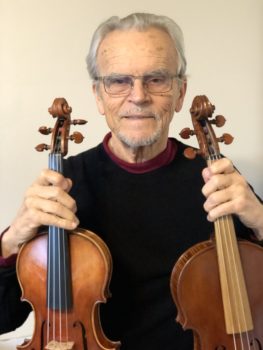Retired Prof, Violin Expert, Disputes New Study’s Surprising Findings

Joseph Nagyvary, a retired Texas A&M University professor who has spent much of his life studying old-world violins and actually making such instruments with the goal of capturing the rich sound of Stradivari and other old Italian violins, takes exception to a recent study that suggests new and less-expensive violins sound better.
“The study is meritorious in some respects — and I applaud the effort — but I cannot accept the conclusion and implication which is offered as definitive that new violins are preferred by concert soloists,” Nagyvary states. “As it is, the work cannot be considered in any way scientific and conclusive.”
The study to which he refers was conducted by Claudia Fritzand colleagues at the Jean Le Rond d’Alembert Institute in Paris and published in the Proceedings of the National Academy of Sciences.
Fritz’s team gave six new and six old violins to 10 musicians; five of the violins were Stradivari. The musicians stood in dim light, wearing dark glasses, and were asked to play each violin in a rehearsal room and in a concert hall. When asked which violins they preferred, six of the musicians selected the new violins.
“On average, soloists rated their favorite new violins more highly than their favorite old for playability, articulation, and projection and at least equal to old in terms of timbre. Soloists failed to distinguish new from old at better-than-chance levels,” according to the study.
Nagyvary, a professor emeritus in biochemistry, has himself been published in numerous scientific journals on the subject of violins. Upon examination of the Fritz study, Nagyvary concludes that the old violins used in the test must have been in poor condition.
“The serious weakness of this work lies in the old violins not being identified,” he says. “Experts, including myself, know well that the 600 or so extant Stradivari violins vary vastly in their tone quality due to their playing and preservation history. Those with 100,000 hours of playing and 30 cleats and layers of new wood in their interior are much different from the few in almost pristine condition. Many Stradivari violins, having gone through the hands of French restorers, have been re-varnished to some extent. Many of these are in dubious acoustical condition.”
Nagyvary points to several Stradivari violins in particular he says must not have been used in the experiment, otherwise the results would not have been the same.
“One can assume these five Stradivari were not the ones owned by David Fulton which were exhibited in Oxford last July and demonstrated to be superior by James Ehnes,” he notes. “Surely, the Stradivari of Joshua Bell was not among them.
“The owners of the best Stradivari, in my experience, would not submit their violins for such tests,” he continues. “My guess is that among the six old violins there was only one decent Stradivari.”
He says the implication of the experiment is that there is no need to spend millions of dollars for a Stradivari violin in order to make a great impression on the concert stage. “As a researcher and maker of new violins, I know that violin making has made enormous progress during the last 25 years due to many scientific discoveries,” he notes, “and so the best of the new can be better than the average Stradivarius violin.”
The scope of the experiment was too narrow for a truly accurate assessment of the violins, Nagyvary points out. “For example, tone quality, tone color or timbre is not something even a concert artist can evaluate without playing the violin for weeks,” he explains, referencing his own article published in The Savart Journal, which describes what he says are better ways of evaluating tone quality.
He says a real contest would be pitting the best vs. the best: “The world would welcome an experiment pitting the consensus-best 10 Strads and del Gesus against 10 prize-winning new violins.”
Media contact: Lesley Henton, Texas A&M Division of Marketing & Communications.





